BELFAST: HISTORICAL AND DESCRIPTIVE.
By John Vinycomb, M.R.I.A.
-- -- -- -- --
BELFAST LOUGH AND HARBOUR.
THE City of Belfast is situated at the extremity of Belfast Lough, formerly called Carrickfergus Bay, from the town and castle of that name, and at a period when Belfast was too insignificant a place to be noticed upon maps of the time. The lough is an arm of the sea, about twelve miles in length, the breadth at the entrance is about five miles, which decreases gradually towards the extremity where the river Lagan joins it at the city harbour, with its miles of quays and docks for foreign-going ships, iron shipbuilding and marine engineering works, etc., which here line both sides of the harbour.
On approaching Belfast by steamer, the stranger cannot fail to be struck with the picturesque beauty of the lough, the smiling villages scattered along its margin, and the hills rising behind on either side, running in a nearly parallel course from the entrance of the lough, and stretching far away up the valley of the Lagan. On the County Antrim side the most prominent of the hills near the city are Ben Madighan, now called CAVE HILL (1,188 feet), with its bold precipitous cliffs and the great prehistoric fort of MacArt standing out in bold relief on its highest point; the Black mountain (1,273 feet), with Divis (1,507 feet) rising behind it, and overlooking the city; while the range of the Castlereagh hills appears on the southern or County Down side of the valley.
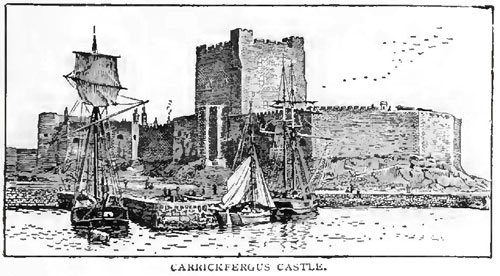
One of the first places of importance that meet the eye on entering the lough is CARRICKFERGUS CASTLE, the great military stronghold of the Anglo-Norman invasion, built by John de Courci in 1177, standing conspicuously on the northern shore. It still remains in perfect condition, notwithstanding the many sieges and captures it has undergone in troublous times; it can only now be viewed as a picturesque relic, and quite useless as a place of defence.On the southern or County Down side, at the entrance of the lough, is the ancient monastic town of Bangor, a favourite place of resort for summer visitors at the sea-side. Not far from Bangor is CLANDEBOYE, the ancestral home of the late MARQUESS OF DUFFERIN AND AVA; upon the wooded hill behind stands HELEN'S TOWER, erected by Lord Dufferin in 1847, on his coming of age, as a token of love for his mother, Helen, Lady Dufferin. Tennyson and Browning, Haughton and Kipling, have, in immortal verse, made the tower for ever memorable.
HOLYWOOD, a pleasant sea-side village of some 4,000 inhabitants, four miles from Belfast, on the road to Bangor, was also an ancient ecclesiastical seat of importance.
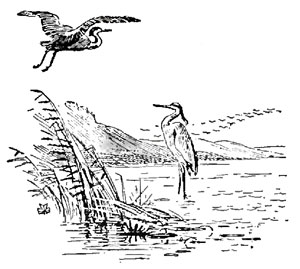
In 1613 the lough extended into what is now the heart of the city. Various extensions of the land have taken place from time to time, and where once the lonely heron waded undisturbed in the shallows of the lough, the harbour works have extended for miles into the sea, and the ceaseless din and hammering of the iron shipbuilding yards and engineering works fill the air. Hundreds of acres of land have been reclaimed from the lough on either side of the river, on which extensive ranges of warehouses and docks for the accommodation of foreign shipping have been constructed, and for the carrying on of the iron and steel shipbuilding, for which Belfast is now famous.

A rambling old bridge of twenty-one arches formerly existed here, erected in 1689, over which Schomberg's heavy artillery, in passing in the same year, caused such damage, that three years later a large portion collapsed, and so remained until comparatively recent times. The present QUEEN'S BRIDGE was built in 1843. Anciently a ford existed at or near this place, from which the town takes its name (BEL or BEAL, a mouth, a ford, an entrance, and FEARSAD, a sandbank).
THE RIVER LAGAN. -- According to O'Donovan the Irish word lagan signifies a hollow or narrow district between hills or mountains. The river takes its rise in Sliebh Croob (Slieve Croob), in the heart of County Down; its course beyond the city is now mainly a canal, and passes through some most charming scenery. It is a favourite haunt of artists and lovers of nature, the tow-path affording a delightful walk for many miles amid picturesque surroundings.
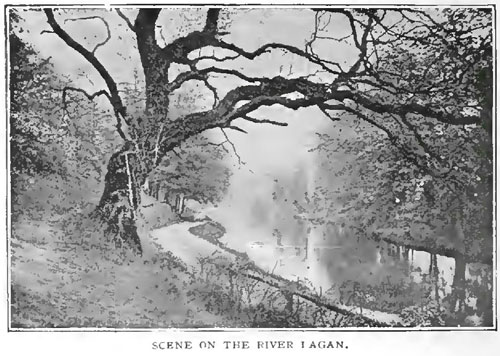
The Lagan is a stream of no considerable size, but, with the deepening of the channel and the creation of the harbour, it has been utilized as a water-way into the interior of the country. The inland trade by water is carried on by the LAGAN NAVIGATION COMPANY, which connects the HARBOUR OF BELFAST with LOUGH NEAGH, and by the ULSTER CANAL, which connects LOUGH NEAGH with the UPPER and LOWER LOUGH ERNE.
Four bridges now span the river in its course through the city. From the Queen's Bridge, which joins the city proper with its populous suburb, BALLYMACARRETT (Bally MacArt, the town of MacArt [O'Neill] ), there is a quay of two miles for steamboats the whole length of DONEGALL QUAY, extensive docks and shipbuilding yards, beyond which there is a straight course out to the open sea. QUEEN'S QUAY on the County Down side is devoted to the discharging of coal steamers; beyond this are Abercorn Basin and Queen's Island Shipbuilding and Marine Engineering Works. An extensive reclamation of land is at present being made on the County Down side, and the formation of the new MUSGRAVE CHANNEL, which will very largely increase the accommodation of shipping interests.

A daily service of steamers is carried on between Belfast and the principal cross-( hannel ports. There are also weekly, bi-weekly, and tri-weekly sailings to many other British ports, besides regular steamers trading to various foreign countries. Steam-ferries, which cross the harbour at different points, ply regularly during the day. A range of capacious sheds, for the protection of cargo waiting shipment or delivery, extends the entire length of the steamboat quays, and the different railway companies can bring their goods trains along the quays for direct shipment, or vice versá, of goods in transit.
THE HARBOUR COMIMISSIONERS (Sir James Musgrave, Chairman), who control and regulate all matters connected with the Port and Harbour Trust, have their offices in a handsome and commodious building, situated near the Clarendon Dock.
THE CUSTOM HOUSE and INLAND REVENUE OFFICE is a substantial building facing the quay, at the foot of High Street. On the esplanade in front are two forty-six pounder Russian guns from Sevastopol.

The first great stimulus to the trade of the port was given by Lord-Deputy Wentworth in 1637, who purchased from the Corporation of Carrickfergus, then the chief town of Ulster, the right of importing certain commodities at one-third of the duties payable at other places.
HISTORY OF BELFAST.
"BELFAST as a town has no ancient history," and does not lay claim to a remote origin like so many towns in Ireland. Its record is simply one of industrial progress, dating no farther back than the time of James I. In later times, however, it has been remarkable alike for its rapid growth in area and population, no less than for the commercial enterprise and intelligence of its citizens. As the capital of the Province of Ulster, andthe great manufacturing and commercial centre of Ireland, Belfast occupies the unique position of being the most progressive city in the country -- possibly in the United Kingdom. In 1757 it contained only 1,779 houses, mostly straw-thatched, and a population of 8,549, which has gone on increasing until it amounts to 348,965, according to the census of 1901; the area of the town, however, having been largely increased so as to include all the suburbs. It is still considerably below Dublin, if that city had included within its area a proportionate amount of the surrounding districts. As it is, Belfast occupies the eighth place among the cities of the United Kingdom.
At the banqutet given in Belfast to the late Lord Dufferin on his return from his last great diplomatic mission, his lordship said: "To a resident, the rate of progress which has taken place in Belfast during the last few years must have appeared very rapid; to one who, like myself, revisits the city after a considerable lapse of time, the change is simply marvellous; and well may we all be proud that a place which was of comparatively small account, and was certainly not a county town, should now rank as a great commercial city of the United Kingdom."
In 1600 Belfast boasted of but five streets, composed of thatched houses irregularly built and badly lighted, giving little indication of the size it was destined to attain in the present day. The few streets which formed the nucleus of the old town are fast disappearing under the march of city alterations; scarce one now remains of the quaint old houses of the days when the merchant lived over his place of business; wider streets are taking their place, with large buildings in all the leading thoroughfares. Vast areas are occupied by streets of workmen's dwellings in certain districts, while the residences of the merchants and gentry are mostly in the suburbs.
As to the early history of the town little can be said. The place is mentioned in the Annals of the Four Masters as the scene of a battle, in A.D. 660, between the Ulidians and Cruithni, which took place at the Ford or Fearsat, which was the name given to the place from the sandbank at the mouth of the little river which flows through Belfast, now running underground -- Bel or Beal Fearsat being the early name of the place. In 1177 John de Courci, an Anglo-Norman knight, held possession of the counties of Antrim and Down, and of what was the first CASTLE OF BELFAST of which there is any mention, and which he probably erected on an ancient site commanding the ford.
King John (1210) passed through Belfast on his way to Carrickfergus. It is impossible to trace the history of the place as a town till the reign of Edward II., at which period the Irish, galled by the oppression of the English, invited the Scots, under Edward Bruce (1316), brother of the Scottish king, to invade Ireland and expel the English. He hoped to found an independent monarchy by uniting all the Irish septs. Landing at Olderfleet, near Larne, with 6,000 men, and having been joined by the Irish chiefs, Bruce "fell with the fury of a devouring tempest upon the English settlements,"and the town and castle of Belfast were destroyed. He was defeated and slain in a conflict near Dundalk by the English later on. Could he have realized his ambition, the later history of Ireland might have been very different.
The distraction consequent upon his defeat, and the subsequent murder of William de Burgo, Earl of Ulster, in 1333, by his own kinsman, at the Ford or Fearsat, did much to lessen the power of the Anglo-Normans; the Irish clans rose in arms, and, with the exception of the stout fortress of Carrickfergus, this portion of Ulster remained for a long period in the hands of the Irish.
In 1503 Gerald, Earl of Kildare, Lord-Deputy of Ireland, made an expedition into Ulster and destroyed the Castle of Belfast. Kildare made a second excursion into the north and again destroyed the castle, which had in the meantime been fully erected and re-occupied by the O'Neill. The castle seems to have been the scene of many a sanguinary encounter, being taken and retaken several times during this troublesome period.
The entire district was granted to the Earl of Essex, who was appointed Lord-Governor of the Province of Ulster by Queen Elizabeth in 1573. His chief camping-ground was at Belfast, which he proposed to make a fortified town and build a bridge over the river -- schemes of which proved abortive. Notwithstanding his high favour with the Queen, his expedition to Ireland was not successful : Essex displeased Elizabeth, and was recalled.
Sir Arthur Chichester, a Devonshire man, who had been appointed by the Earl of Essex Governor of Carrickfergus and the two Clannaboys, was made Lord-Deputy in 1604. He also received a grant of the town, manor, and castle of Belfast, and may truly be called the founder of the town. He was created, in 1612, Baron Chichester of Belfast. At this time the place was a mere village of a few scattered huts of about 500 inhabitants, on the margin of the lough, and clustering for protection near to the castle; the FORD, the CASTLE, and the CHURCH forming the three distinguishing features of the place which made the locality known in early times. Upon his advice Belfast was constituted a Corporation by charter of King James I., to consist of a sovereign, or chief magistrate, and twelve burgesses and commonalty, with the right of sending two members to the Irish parliament.
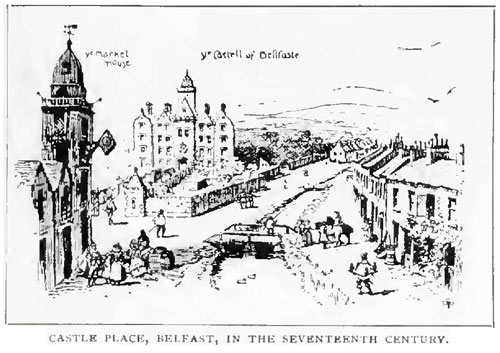
Sir Arthur Chichester, in 1611, built a castle upon or near the site occupied by the former castles, and which an old writer in 1635 describes as "a stately palace which is indeed the glory and beauty of the town." This, the last of the fortified castles erected to hold and control the pass of the ford, was burned down, in 1708, through the carelessness of a servant, by which accident three daughters of Arthur, third Earl of Donegall, were burnt to death. The castle stood in the middle of an extensive garden, between what is now DONEGALL PLACE and CORN MARKET; many names in the vicinity, as Castle Street, Castle Place, etc., sufficiently indicate its proximity. Of this castle not a vestige now remains, the whole area of the castle, with its pleasure-grounds, being built over. Sir Arthur, the Lord-Deputy, died in 1625, and was succeeded by his brother. Lord Edward, afterwards Viscount Chichester, whose eldest son was created Earl of Donegall in 1647; and, subsequently, a descendant, Arthur, fifth Earl, was raised in 1791 to the dignity of Marquis of Donegall and Earl of Belfast.
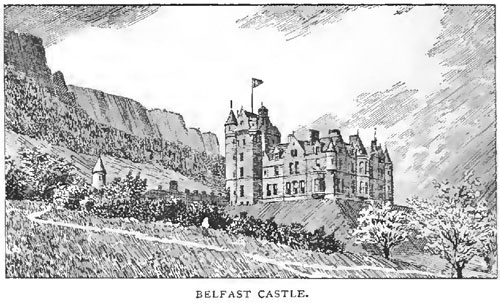
The Chichester family, as lords of the soil, have been closely identified with Belfast and its interests all through its history. The mansion at Ormeau, on the east side of the river, was long the country residence of the family (now one of the public parks of the city, and well worthy of a visit). They had also a town house in Donegall Place, since demolished, and the site occupied by business premises. The third marquis built a magnificent residence (Belfast Castle) on the south-eastern slope of Cave Hill. Upon his decease in 1883 (his only son, the talented Earl of Belfast, having predeceased him in 1853), the title devolved upon his brother. Lord Edward Chichester. Belfast Castle was inherited by his daughter Harriet, the late Countess of Shaftesbury, along with the Irish estates, and now held by her son, the present Earl of Shaftesbury.
A word may be here added as to the elements that went to form the character of the people settled in the North of Ireland. In addition to the settlers brought over from Devonshire by Sir Arthur Chichester, the special inducements offered to needy Scottish adventurers induced large numbers to cross over to Ireland. The encouragement offered to settlers by the plantation scheme of King James proved a welcome refuge for the turbulent and sturdy "Border rievers," and also to many adventurers, who sought to push their fortunes where good land could be cheaply obtained on the confiscated estates. The grants by the Crown to the original "planters" were usually made on the express stipulation that a certain number of families out of England and Scotland should be planted on the lands. Belfast as a centre of commercial life dates from that period. Trade tokens were issued by merchants in lieu of current coin; ships purchased, dues exacted, and all the other mercantile pursuits actively engaged in of a young and vigorous community.
In the wars of 1641, the colonists were harried and stripped of everything by the Irish under O'Neill. It was only when William of Orange landed at Carrickfergus that anything like peaceful times were enjoyed by the people. The colonists received him with an outburst of enthusiasm and affection, which the lapse of two centuries has failed to diminish. Modern Belfast certainly owes very much of its reputation to the character and qualities of the Scottish settlers of King James's time, and the constant traffic they maintained with the neighbouring coast of Scotland. Much of the growth of later date is due to the influx of settlers from all parts of the United Kingdom attracted by its trade and prosperity; the combination of races has tended to produce a community not exceeded by that of any other part of the Empire for modern business aptitude;: in fact, Belfast has often been compared to an American city for its push and appearance. Friction sometimes does arise between sections of the rougher elements, as in other places. Let us charitably suppose that this may be only an indication of superabundant energy, which, with the spread of education and refinement, will by-and-by tone down into mutual esteem and good-will.
CHARTERS, INSIGNIA, &c.
ON the 27th April, 1613, Belfast, then a small town, was constituted a Corporation by charter of King James I., to consist of a sovereign1 or chief magistrate, and twelve burgessesand commonalty, with the right of sending two members to parliament. This charter was annulled by King James II , and a new one issued in 1 688, but the original one was restored in 1690 by William III2
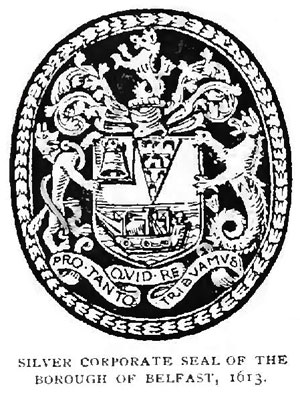
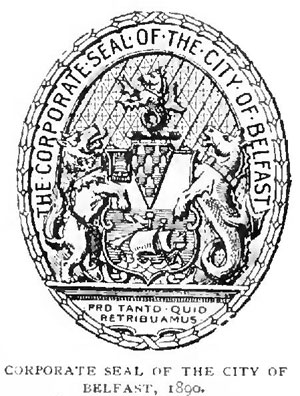
In conformity with the passing of the Municipal Corporation Act of 1841, the constitution of the Corporation was changed, and made to consist of ten aldermen and thirty councillors, under the style and title of The Mayor, Aldermen, and Burgesses of the Borough of Belfast. The progress of the town meanwhile has been so great, that, in the jubilee year of her late Majesty, application was made that the Borough might be constituted a City. Accordingly a Royal Charter was issued in 1888 conferring the rank of a city upon Belfast, with all the "rank, liberties, privileges, and ininiunities" as are incident to a city.
In August 1890 a grant or confirmation of the arms so long borne by the town was obtained from Sir Bernard Burke, Ulster King of Arms, with a slight modification or augmentation of honour, to mark the accession to the rank of a city. A new town seal in accordance therewith was subsecjuently made, and is the one now in use.
In 1892 Her Majesty Queen Victoria conferred upon the Mayor of the city for the time being the style and title of "Lord Mayor," and upon the Corporation of the city the name and description of "THE LORD MAYOR, ALDERMEN, AND CITIZENS OF THE CITY OF BELFAST," the Chief Magistrate, Sir Daniel Dixon, holding office at the time. He now again holds office as Lord Mayor (1901-1902).
By the passing of the Belfast Corporation Act of 1896, the boundary of the city was greatly extended, and the Corporation made to consist of fifteen aldermen and forty-five councillors, and the number of wards was increased from five to fifteen.
By virtue of the Local Government (Ireland) Act, 1898, Belfast became a County Borough 1st April, 1899, and for Assize purposes "The County of the City of Belfast," with a High Sheriff The first High Sheriff appointed by the Lord Lieutenant was Alderman Sir James Henderson, M.A., B.L., J.P. ex Lord Mayor. The present High Sheriff is Alderman Samuel Lawther, J.P. A special chain and badge have been provided for the High Sheriff.
The original Charters, Maces, and other Official Insignia are carefully preserved by the Corporation. The two silver maces of the old borough -- the smaller dating from 1639, the other, which is seventeen inches in length -- are also of the Stuart period.3 Neither of them, however, is worthy of the city. With the opening of the new City Hall, it is to be hoped a new and handsome city mace will grace the proceedings. The gold chain of office worn by the sovereigns of the old borough was presented by the Earl of Donegall in 1787; the present, and more elaborate, chain of office dates from 1873-4. A chain, to be worn by the Lady Mayoress for the time being, was subscribed for by Members of the Council and Town Clerk, on 1st February, 1897 : the then Lady Mayoress (Mrs. Pirrie) was invested with it.
ROLL OF THE HONORARY BURGESSES OF THE CITY OF BELFAST.
(1) Alderman the Right Hon. W. J. Pirrie, P.C., elected 1st January, 1898.
(2) Thomas Henry Ismay, J.P., D.L., Dawpool, Thurstaston, Cheshire, elected 1st Feb., 1899; died 23rd November, 1899.
(3) The Most Hon. the Marquess of Londonderry, K.G., elected 1st March, 1900.
(4) The Most Hon. the Marquess of Dufferin and Ava, elected 1st March, 1900; died 12th February, 1902.
(5) General Sir George White, V.C, G.C.E., etc., elected 11th May, 1900.
(6) Field-Marshal the Right Hon. Earl Roberts, V.C, G.C.B., etc., elected 9th October, 1900.
MUNICIPAL INSTITUTIONS, &c.
KEEPING pace with the civic changes already referred to, there have been formed at different periods THE BOARD OF THE BELFAST HARBOUR COMMISSIONERS, an elected body, who control great and important trusts (see page 5); THE BELFAST CITY AND DISTRICT WATER COMMISSIONERS, who control the WATER SUPPLY; THE CHAMBER OF COMMERCE, and various other public bodies and institutions, such as were rendered necessary by the ever-increasing requirements of the city.
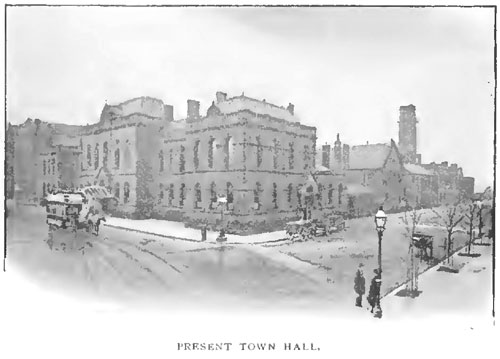
The various departments of the municipality have their headquarters at the TOWN HALL in Victoria Street, not far from the Albert Memorial, while near at hand is the chief FIRE STATION, erected in 1893 (it is also the station of the AMBULANCE CORPS), one of the most complete from every point of view in the United Kingdom; while sub-stations and alarm stations are placed in various parts of the city, and in telephonic communication with the head office. It is admitted on all hands that the members of the Fire Brigade are excelled by none in promptitude and daring.
The RECORDER'S COURT and POLICE COURTS are situated immediately behind the present Town Hall. The ROYAL IRISH CONSTABULARY, who are the guardians of the peace of the city, have a large and commodious barrack adjacent. The nominal strength of the force in Belfast, sergeants and constables, on 31st January, 1901, was 933, at an actual cost to the city (1900) of £16,732 2s. 2d. The GAS AND ELECTRIC LIGHTING of the city is under the control of a Committee of the Corporation.
While attending to the material interests of the citizens, the Corporation have not been unmindful of the health and pleasurable recreations of the people. There are seven PUBLIC PARKS. With the exception of Victoria Park, reclaimed from the lough, they are all tastefully laid out and planted, and kept in excellent condition.
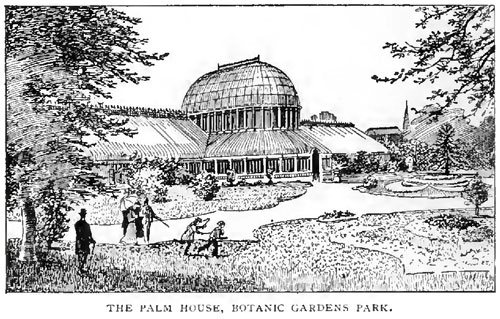
ORMEAU PARK, of 100 acres, the old seat of the Marquis of Donegall, is a charming place, full of well grown tunber and laid-out flower gardens; FALLS PARK (44 acres), which adjoins the City Cemetery, is on the slope near the foot of the Black mountain; BOTANIC GARDENS PARK (14 acres), adjoining the Queen's College, has a fine palm-house, fernery, orchid, and plant-houses. Tram-cars go from the central junction (Castle Place) to all the parks : the tram officials will direct visitors.
The other parks are -- ALEXANDRA (10 acres), WOODVALE (24 acres), and DUNVILLE (4½ acres). The Dunville Park was presented to the city; the others were acquired at the COST OF THE CITIZENS.
BATHS, WASH-HOUSES, and LODGING-HOUSES are established and conducted in various parts of the city under a Committee of the Corporation, as are also the FREE PUBLIC LIBRARY, ART GALLERY, and MUSEUM, which are situated in Royal Avenue.
The beautifully situated and tastefully laid-out CITY CEMETERY, Falls Road, is another of the many departments managed by the City Council. The various committees, which meet regularly at stated times for the transaction of business, are -- POLICE, CEMETERY AND PARKS, ASYLUM, MARKETS, IMPROVEMENT, PUBLIC HEALTH, FINANCE, LAW, LIBRARY AND TECHNICAL INSTRUCTION; BATHS, WASH-HOUSES, AND LODGINGS; GENERAL PURPOSES, and several of special or lesser importance.
STATISTICS.
The area within the municipal boundary is 16,503a. 3r. 26p.
The valuation of the city for municipal purposes was -- In 1841 £135,000; In 1871 £460,802; In 1891 £1,160,051
Corporation redeemable stock outstanding£1,608,030
Population of the city (1901 ) 348,965
Parliamentary voters in the four divisions : North - 12,388; South - 13,669; West 10,961; East - 18,903
City Taxation :
Houses under £20 ... 4/5 in the £1 Houses over £20 ... 5/-in the £1 Poor Rate 1/- in the £1
Rate per 1,000, based on estimated population of 359,000: Births, 32.1; Deaths from all causes, 21.3; Zymotic diseases, 2.1.
The County Borough of Belfast returns four members to the Imperial Parliament.
THE STREETS AND CHIEF PUBLIC BUILDINGS.
OF the numerous public buildings, none are of early date or possess any interest for the antiquary. The city is notable more particularly for its spacious well-kept streets, and the buildings, at once substantial and handsome; some of the newer business thoroughfares, as Royal Avenue, are particularly fine. The NEW CITY HALL, however, promises to be the centre of the city. The extensive business house of ROBINSON & CLEAVER, one of the show-places of the city, at the corner of Donegall Place; that of RICHARDSON, SONS & OWDEN, facing the City Hall; the large range of buildings erected by the SCOTTISH PROVIDENT SOCIETY, and the Y.M.C.A. BUILDINGS, already give the lead to others in course of erection, or in anticipation, in the neighbourhood of Donegall Square; while the NEW TECHNICAL INSTITUTE, on the grounds of the Royal Academical Institution, and the NEW PRESBYTERIAN ASSEMBLY HALL, now in course of erection, will still further contribute striking important buildings in the leading streets.
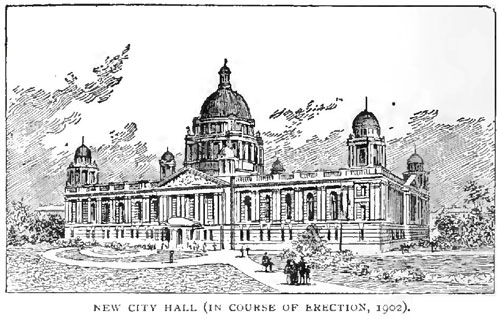
Belfast has its wants fairly well supplied with public buildings of various kinds -- churches, colleges, educational and other institutions, hospitals, banks, hotels, clubs, etc.; while new districts are being opened up, where lengthening streets of private houses keep in line with the ever-increasing population.
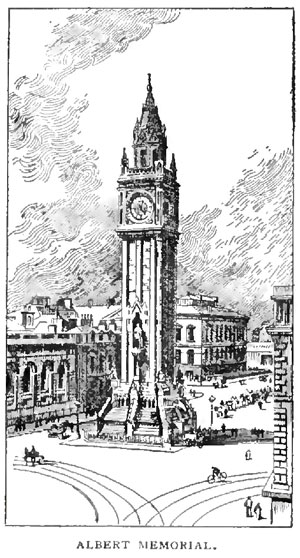 HOW BEST TO SEE THE CITY.
HOW BEST TO SEE THE CITY.
Some of the Principal Buildings, &c.
FOR the purpose of viewing the city, no better plan can be adopted by the stranger than by taking the tram-lines as the routes to be followed. From CASTLE JUNCTION -- THE CENTRE OF THE TRAMWAY SYSTEM, and in the very heart of the city -- excursions can be made in various directions. From the top of a tram-car an excellent view is obtained, and a few hours may be profitably and pleasantly spent in this way in getting a general view of the streets and suburbs.
The most notable monument in Belfast is the ALBERT MEMORIAL CLOCK TOWER at the foot of High Street, close to the steamboat quays and the Custom House. Only two other monuments at present stand in our public streets -- statues of eminent local divines : DR. COOKE, opposite the Royal Academical Institution, and DR. HANNA, at Carlisle Circus. A very handsome STATUE of HER LATE MAJESTY, in commemoration of her DIAMOND JUBILEE, has been executed, and will be placed in front of the New City Hall facing Donegall Place. Beside it, one of Sir Edward Harland, the founder of the Shipbuilding Works, is readv for erection. Funds have also been subscribed on a liberal scale for a great statue in memory of the late Lord Dufferin. The beautiful statue of the Earl of Belfast, by Patrick Mad )o well, which formerly stood on the site of Dr. Cooke's statue, is now in the Free Library.
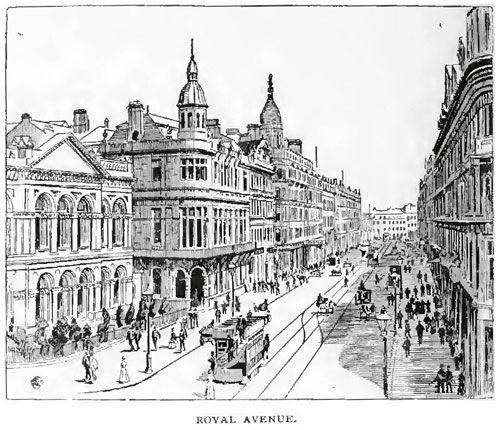
Reference may be briefly made to some of the leading thoroughfares. Standing in Castle Place, opposite the "BANK BUILDINGS," the eye wanders to the right along ROYAL AVENUE, a wide and well built street, which may now be considered the principal thoroughfare of the city, joining, as it does, several important outlying parts of the town to the centre. The buildings close at hand are the PROVINCIAL BANK, and next to it the REFORM CLUB; farther on, the GRAND CENTRAL HOTEL; and on the opposite side, the ROYAL AVENUE HOTEL and the offices of the CITY AND DISTRICT WATER COMMISSIONERS, a handsome building of red sandstone. The GENERAL POST OFFICE and the Free Public Library, Art Gallery, and Museum are also situated in this street.

Turning to the left hand is DONEGALL PLACE, on a line with Royal Avenue; it also has some very fine places of business, with Robinson & Cleaver's at the opposite end. This important street leads direct to the NEW CITY HALL, occupies the site of the old Linen Hall, covering about five acres of ground, forming Donegall Square. In this neighbourhood are situated most of the great linen warehouses and town offices of the linen manufacturers.
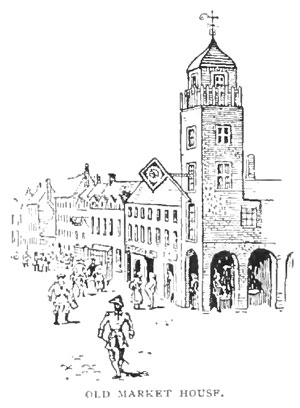
Looking down Castle Place, the eye is attracted to the large building on the left -- the ULSTER CLUB -- the city rendezvous of country gentlemen and wealthy business men. Directly opposite, on the right, where the line of shops now stands, was the site of the castle and pleasure gardens of the great Lord-Deputy, Lord Arthur Chichester, referred to on page 9. The entrance to the castle was at the corner of Corn Market. Directly facing the entrance, on the site of Forster Green's premises, stood the OLD MARKET HOUSE, the centre of corporate life of the town for many a long day.
Looking from Corn Market down High Street towards the river, the ALBERT MEMORIAL meets the gaze. This is one of the oldest (and the principal) streets of old Belfast.
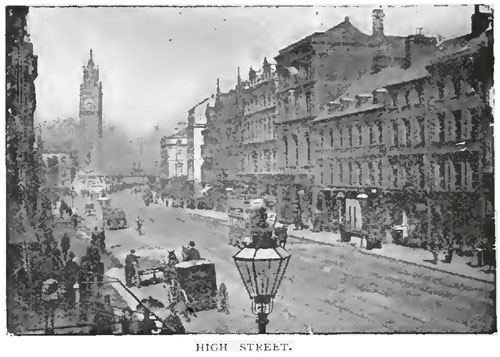
The little river Farset ran down the middle of the street between green banks in the old days: it is now, happily, underground. At Bridge Street, a stone bridge crossed the stream; hence the name. Many fine shops grace this thoroughfare. Following the tram-line along Bridge Street to Donegall Street, we come upon the magnificent Cathedral, now being built on the site of the old parish church of Saint Anne. (See illustration on next page.)
The illustration shows the design, by Sir Thomas Drew, P.R.H.A., for the Cathedral. At present only the nave and aisles are being built. The design as a whole must await, for its realization, a time when larger funds are available. The first section, the completion of which is expected in about a year from the present time, will however provide a large church which can be used for all cathedral pur-poses, and which will hold a congregation of nearly 2,000 people.
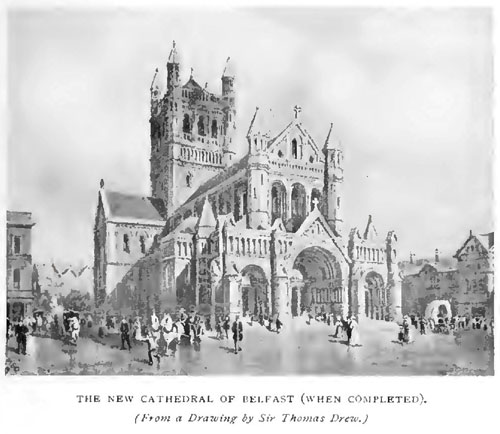
Architecturally, the Cathedral will mark an interesting departure from custom. The traditional Gothic type has been abandoned, as it was found that a vast outlay would have been necessary in order to provide a Gothic cathedral of noble design, and at the same time large enough to meet the needs of the overflowing population of a modern city.
Belfast Cathedral is to be Basilican in its general type. This primitive model has been found to be far more easily adapted to modern congregational purposes than the mediaeval type, and to be far less costly in proportion to the accommodation provided.
Sir Thomas Drew writes : "The new Cathedral will have a forty-foot nave. The disposition of its parts will be broader and simpler, with fewer arches springing over wider spans, than in a typical Gothic church . . . The plan and proportion of the church are singularly simple and arithmetical. A nave of 40 feet, aisles of 20 feet width, six bays of the nave, each of 20 feet; the crossing, transepts, and chancel, each within their piers, square of 40 feet; the internal height of the aisle walls 36 feet, and of the walls of the nave and its clerestory, 72 feet . . . The whole length internally when complete will be 214 feet.
"For what is known as architectural 'style,' the architect has had to adapt his design to what seemed to him harmonious with a Basilican plan . . . He has adopted a round-arched treatment, the main suggestion of which comes from that Byzantine source which impressed itself on the early church architecture that came through Italy by way of the South of France to England and Ireland, and gave us in these countries such noble round arched architecture as may be seen at Cashel or Durham or Tuam. The striking 'Romanesque' architecture of southern France presents, perhaps, the purest type of a noble architecture which is suggestive to an architect and consonant with the Basilican plan."
When complete, the Cathedral will be a very large and impressive building. The nave and its turrets will rise 105 feet above the pavement of Donegall Street. The summit of the central tower will be 175 feet above the same level. The great central portal of double doors will form a very striking and beautiful feature. It is on the same scale as the west portal of the Cathedral of Genoa. The entire building will hold a congregation of 4,000.
The beginning of this great work was due to the energy and enthusiasm of the first Dean of Belfast (the present Bishop of Cashel) and the generosity of the late Countess of Shaftesbury. The foundation-stone was laid by the present Countess of Shaftesbury on 6 September, 1899.
The first section, which is now in process of building, will cost £30,000. Of this amount, £25,000 has been already subscribed. The remaining £5,000 is urgently required. The rest of the design will be realized, in sections, when funds are available for the purpose.
CHURCHES, &c., WITHIN THE CITY.
BELFAST may be said to be fairly well supplied with places of worship; some of them are of considerable architectural beauty, but most are plain and unarchitectural.
| Church of Ireland | 38 |
| Presbyterian | 55 |
| Methodist | 33 |
| Roman Catholic | 18 |
| Non-Subscribing | 5 |
| Various denominations | 20 |
| Total | 169 |
Nor is Belfast wanting in charitable and benevolent institutions, chiefest among which is the Royal Hospital, Frederick Street.

During the year 1897 an important project was undertaken, with a view of marking the Diamond Jubilee of the Queen, of raising £100,000 for the purpose of building a new hospital. Mrs. Pirrie, the Lady Mayoress, entered very warmly into the project, and, largely owing to her untiring energy, the entire sum was subscribed. The institution, which will bear the name of the "Royal Victoria Hospital," is being built on finely situated grounds on Grosvenor Road. Efforts are being made to secure an adequate endowment fund.
THE MATER INFIRMORUM HOSPITAL, Crumlin Road, a similar institution for the relief of the sick and suffering, was erected under the auspices of the Roman Catholic body, and placed under the care of the Sisters of Mercy.The total outlay for building and equipping the hospital was about £50,000. There are also various other hospitals for the treatment of special diseases, all of which are doing good work.
The BELFAST CHARITABLE SOCIETY is the oldest charity in Belfast, having been opened for the admission of the sick in 1752. Since the coming into operation of the Irish Poor-Law Act, the charity has been in its practical operations limited to the class of decayed citizens, reduced tradesmen, artisans, and servants; the admission being by election. The institution is supported by voluntary contributions, and by the rental of certain grounds and houses which have been erected on the land contained in the original grant. The charitable and benevolent institutions in the city are numerous and well supported.
COUNTY ANTRIM COURT HOUSE, Crumlin Road, a handsome structure with stone portico. It comprises two commodious courts, the Crown and Record, with adjoining rooms for the barristers and solicitors engaged, and accommodation for the Grand Jury, the County Council, and County officers. On the opposite side of the road is the County Jail : an underground passage connects the two buildings.
The MILITARY BARRACKS, North Queen Street, among the finest and most commodious in Ireland. New barracks were, a few years ago, erected in Holywood, upon an admirable site, known as the Bishop's Palace Grounds, adjacent to which, on the shore of the lough, is the Kinnegar Rifle Range, leased by the Government.
The SOLDIERS' HOME, in Clifton Street, a handsome and commodious building, opened in 1891, has contributed in no small degree to the welfare of the troops located in the Belfast garrison.
PLACES OF AMUSEMENT AND PUBLIC HALLS.

THE THEATRE ROYAL, in Arthur Square, is a fine building, with all the usual arrangements; the same may be said of the OPERA HOUSE, in Great Victoria Street: both theatres are owned by a limited liability company. The EMPIRE MUSIC HALL and the ALHAMBRA MUSIC HALL are devoted to variety entertainments.
Belfast possesses several very excellent halls for public meetings, concerts, etc. The ULSTER HALL, Bedford Street, is a commodious structure, capable of seating 3,500 persons; it contains a grand organ, provided by John Mulholland, a wealthy citizen, at a cost of 3,000 guineas; there is also a minor hall, capable of seating 400 persons. The Belfast Corporation have now purchased the hall. The Corporation already possess a capacious hall in the Botanic Gardens Park, termed THE EXHIBITION HALL, where many important meetings and receptions are held. The SAINT MARY'S HALL, close to the Bank Buildings, is also capable of seating a large audience. The GROSVENOR HALL is a light, commodious structure, capable of holding a large audience, and is mostly used for popular religious services. There are also a number of other halls in the city for meetings and concerts by the citizens of Belfast.
The city is not wanting in opportunities for the enjoyment of the various forms of athletic Sports, such as cricket, football, lacrosse, lawn tennis, golf, hockey, and bowling.
There are also two clubs for the encouragement of aquatic amusements -- the BELFAST BOAT CLUB and the COMMERCIAL BOATING CLUB. The ROYAL ULSTER YACHT CLUB has its club-house at Bangor, Co. Down. There are also several successful Swimming Clubs in the city.
COLLEGES, EDUCATIONAL INSTITUTIONS, &c.
THE QUEEN'S COLLEGE is a stately edifice in the Tudor-Gothic style of architecture; finely situated in its own grounds of eleven acres, at the west end -- the most beautiful building in the city.
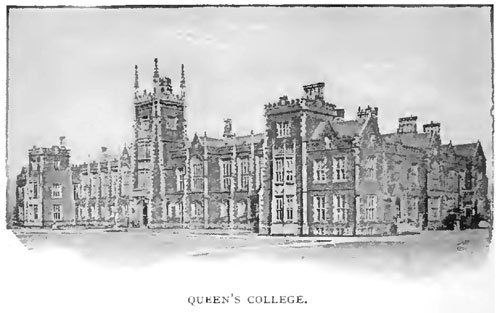
This college, which has sister institutions in Cork and Galway, originally formed the QUEEN'S UNIVERSITY. The distinguished alumni are to be found in all parts of the world. In the ROYAL UNIVERSITY OF IRELAND, which took its place, the Belfast Queen's College continues to hold the premier place.
On Saturday, 11th August, 1849, QUEEN VICTORIA and PRINCE ALBERT visited the college previous to its opening at the latter end of the same year. Adjoining the college grounds is the BOTANIC GARDENS PARK, one of the most beautiful of the public parks.
The PRESBYTERIAN COLLEGE, a handsome block of stone buildings in the classic style, which stands a short distance from Queen's College, was opened in 1853. This college, with Magee College, Derry, now grants theological degrees in connection with the General Assembly of ihe Presbyterian Church in Ireland.
The ROYAL ACADEMICAL INSTITUTION, College Square, founded in 1807 (opened in 1810), at a cost of £30,000, raised by public subscription. Many eminent scholars and statesmen received iheir early training in this great public institution. The new Technical Institute will be built upon portion of the grounds in front.
BELFAST ROYAL ACADEMY, Cliftonville, originally founded in 1785 as "The Belfast Academy." In 1876 the present beautiful building was erected on the outskirts of the city.
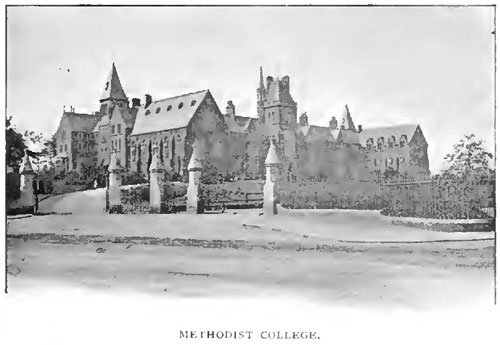
The METHODIST COLLEGE (opened in 1868) comprises an extensive range of buildings of considerat)]e architectural beauty; is in close proximity to Queen's College. It is used as a Theological Training School for candidates for the ministry of the Methodist Society in Ireland, and as a high-class public school for boys and girls.
The CAMPBELL COLLEGE (opened in 1894) is situated in the beautiful demesne of Belmont, at the terminus of one of the tramway lines on the County Down side, 3½, miles from Castle Junction. It was founded in accordance with the will of the late H. J. Campbell of Craigavad, County Down, who left a legacy of about £200,000 for the building and endowment of a high-class public school.
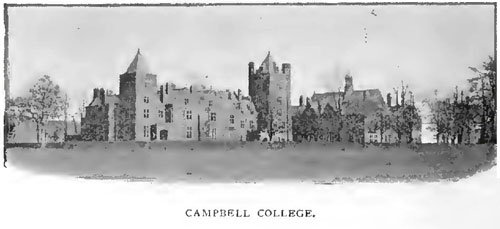
VICTORIA COLLEGE, The Crescent (founded in 1859 by Mrs. Byers for the education of girls), has had a most successful career in the higher education of women.
ST. MALACHY'S DIOCESAN COLLEGE, at Vicinage, a short distance from Carlisle Circus. This Roman Catholic College provides education for boys in all branches of study.
There are numerous educational establishments of a high class in or near the city, of which the foregoing are the principal.
Of public institutions of an educational character may be briefly mentioned the FREE PUBLIC LIBRARY, ART GALLERY, AND MUSEUM, Royal Avenue (opened in 1888); is one of the finest buildings in Belfast. Besides the lending and reference departments, it contains a good collection of antiquities and natural history objects, presented to the city by the late Canon Grainger. A bronze statue of the Earl of Belfast, by MacDowell, a native of the city (who executed the figures of William Pitt, Lord Chatham, and Viscount Exmouth, in St. Stephen's Hall, Westminster, and one of the groups at theAlbert Memorial, Hyde Park), adorns the large hall of the reference library. The Library and Technical Committee of the Corporation also conduct, under the Agricultural and Technical Education Act, a School of Art, and a number of technical classes in temporary premises in various {)arts of the city.
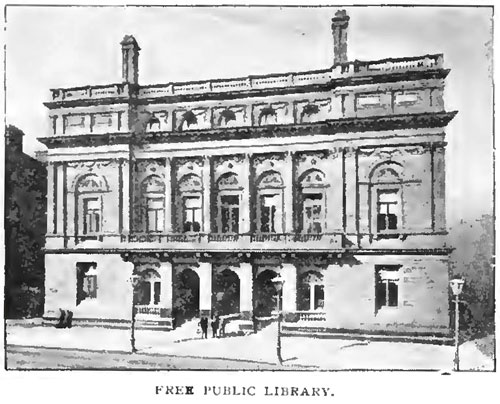
The MUSEUM OF THE NATURAL HISTORY AND PHILOSOPHICAL SOCIETY, College Square North (founded in 1821), contains a good collection of objects. The antiquity-room contains a large series of examples, mainly from the North of Ireland, gathered by the late George Benn. Local archaeology is illustrated by collections contributed by many other antiquarian students. The museum embraces an excellent series of the departments of geology, zoology, and botany. The BELFAST NATURALISTS' FIELD CLUB, now in its fortieth year, holds its winter meetings in the museum. The LINEN HALL LIBRARY, Donegall Square, or, more accurately speaking, the Belfast Society for Promoting Knowledge, was established in 1788. Until recently the library was kept, and the meetings of the society were held, in the central building of the Linen Hall; hence the name which it has so long borne. Since the purchase of the Linen Hall site by the Corporation, the library has been removed to a spacious building close by. Among its literary treasures it contains the GIBSON COLLECTION OF BURNS AND BURNSIANA, a unique collection of over one thousand volumes.
WORKING MEN'S INSTITUTE AND TEMPERANCE HALL, a commodious building at the corner of Castle Street and Queen Street; contains a news-room, an amusement-room and library, and also a large lecture and concert hall. The institute was founded in 1873, and was inaugurated by Lord Dufferin. Science and technical classes, under the auspices of the Corporation, are held here.
The YOUNG MEN'S CHRISTIAN ASSOCIATION, Wellington Place, possess a splendidly-equipped building, with classrooms, gymnasiums, and lecture halls, with appointments of the most complete kind in every way, capable of doing excellent work.
The BELFAST ART SOCIETY, established in 1880, has a suite of rooms at 49, Queen Street, and holds its annual exhibitions in the galleries of the Public Library in the autumn of each year.
MUSIC. -- There are several musical societies, the principal of which are the Philharmonic Society, Belfast City Choral Society, the Ladies' Cecilian Choir, Dr. Price's Male Choir, etc.
There are also societies devoted to literary, medical, and scientific subjects, which it is needless to enumerate.

